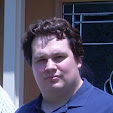Yep, the spacing. See this template was designed for paper witch is very very thin. I'm not sure of the actual measurement, but for the point of discussion we'll say it's 1 sheet thick. The card stock I've using is mostly cereal boxes and the like which appears to be about 15-20 sheet thick. The way this template works is by layering shapes ontop of on another to create raised and recessed details. With some details being 3 or even 4 layers on top of one another that's a 4 sheet height. Cool.
Now take the exact same plans and apply them to card stock which is about 20 times as thick as a sheet of paper. You've got part 3, on top of part 2 on top of part 1. And each is 20 sheets thick. A better explination might be a visual explination:
The image on the left is a series of 1pixel wide shapes stacked on top of each other, while the one on the right is a similar lay out but with 20pixel wide blocks. You can see how the difference in thicknesses adds up, and quickly. Now take this, and compound it by 3 and 4 sub structures and you can wind up with parts that are out of alignment by as much as a 1/4 inch and you have followed the directions perfectly.
This is really the crux of why I'm doing this prototype model in cardstock rather then jumping into plasticard. This project is going to take a lot of plasticard and I want the plasticard version to look built, not slapped together. And I don't want to waste a metric crap ton worth of plasticard either.
So what am I going to do to correct this? Well, one of the nice things about sheet stryene is it's a machined material so it's a consistent thickness. With that in mind I can then go back to the plans and begine breaking down the parts and figure out what pieces of what part will be done with 2mm styrene, what parts will be in 1mm, what will be in .5mm and what will need to be be .01mm sheeting.
So what I'm doing is as I build the model in cardstock, I make notes about how each part lays in the plans and on the finished part. Then dropping the plans into photoshop and color coding those parts to differentiat styrene thickness.
The light blue is indictive of the part being made of 2mm sheet styrene. The light green .01mm sheet and the orange in 1mm sheet. If my measurements are right the parts should lay op on top of one another, and then with a little filler putty, should produce something comparable to the tank kits from Games workshop. I hope anyway. We'll see.
As an aside I've been thinking about lighting. I mean wiring up the model with LEDs and lights.
Now I admit that lighting plan is well above my electrical skills. Hell skills make it sound like I actually know what I'm doing with electronics. All I can do is wire a switch and light to a battery pack. But I also like challenges and I am pursuing several avenues to help me with this.










0 comments:
Post a Comment